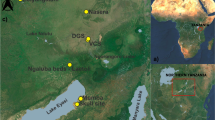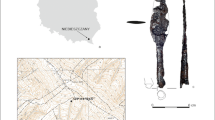Abstract
The present work focuses on majolica objects from the collection of the museum of ceramic in Ascoli Piceno (Italy). The scientific investigation was performed on fragments detached from seven maiolicas attributed to the Castelli production (Abruzzi region) and one majolica from the Ascoli Piceno production (Marche region). The Castelli artifacts (late sixteenth–early eighteenth century) belong to the decorated style known as “compendiario.” The piece from Ascoli Piceno recalls the decoration style of the other considered objects and is attributable to the “Paci” manufacture (first half of the nineteenth century). The selected objects were investigated by fiber optics reflectance spectroscopy, micro-X-ray fluorescence spectroscopy and scanning electron microscopy coupled with electron-dispersive X-ray spectrometry. The ceramic bodies of all objects are calcareous, whereas the glazes are lead-alkali type opacified by tin dioxide. Blue and purplish-red decorations were obtained by cobalt and manganese compounds dissolved in the glaze, respectively. Yellow and orange decorations were obtained by particles of lead antimonate and hematite. Finally, black decorations were obtained using compounds rich in manganese and iron. The study contributes to knowledge on the production of Castelli ceramics and presents first archaeometric data on the maiolica production from Ascoli Piceno. The scientific examination highlights continuity with the Renaissance production, and the joint contribution of the three analytical techniques suggests distinctive features among different productions, thus integrating and refining the information obtained by the art-historical study.







Similar content being viewed by others
References
F. Amato, S. Gualtieri, B. Fabbri, La maiolica italiana di stile compendiario, in I bianchi, ed. by V. De Pompeis (Allemandi, Torino, 2010), p. 33
S. Papetti, L’arte della maiolica ad Ascoli Piceno (Castelli, Dal neoclassicismo al déco (Andromeda, 2006)
S. Papetti, Ascoli Piceno - Pinacoteca Civica. Disegni, maioliche, porcellane (Calderini, Bologna, 1995)
G. Vaggelli, R. Cossio, Analyst 137, 662 (2012)
M. Maggetti, in Archaeological ceramics, ed. by J.S. Olin, A.D. Franklin (Smithsonian Inst. Press, Washington DC, 1982), p. 121
J. Molera, T. Pradell, M. Vendrell-Saz, Appl. Clay Sci. 13, 187 (1998)
M.S. Tite, J. Archaeol. Sci. 36, 2065 (2009)
F. Antonelli, A.L. Ermeti, L. Lazzarini, M. Verità, G. Raffaelli, Archaeometry 56, 784 (2014)
C. Viti, I. Borgia, B. Brunetti, A. Sgamellotti, M. Mellini, J. Cult. Herit. 4, 199 (2003)
C. Piccolpasso, in I tre libri dell’arte del vasaio, ed. by G. Conti (All’insegna del Giglio, Firenze, 1976)
M.S. Tite, I. Freestone, R. Mason, J. Molera, M. Vendrell-Saz, N. Wood, Archaeometry 40, 241 (1998)
M.S. Tite, T. Pradell, A. Shortland, Archaeometry 50, 67 (2008)
J. Molera, T. Pradell, N. Salvadó, M. Vendrell-Saz, J. Am. Ceram. Soc. 84, 1120 (2001)
W.A. Weyl, Coloured glasses (Society of Glass Technology, Sheffield, 1999), p. 121
M. Bacci, M. Picollo, Stud. Cons. 41, 136 (1996)
A. Ceglia, W. Meulebroeck, K. Baert, H. Wouters, K. Nys, H. Thienpont, H. Therryn, Sur. Interface Anal. 44, 219 (2012)
B. Gratuze, I. Soulier, M. Blet, L. Vallauri, Rev. d’Archéométrie 20, 77 (1996)
J. Pérez-Arantegui, B. Montull, M. Resano, J.M. Ortega, J. Eur. Ceram. Soc. 9, 2499 (2009)
S. Lahlil, M. Cotte, I. Biron, J. Szlachetko, N. Menguy, J. Susini, J. Anal. At. Spectrom. 26, 1040 (2011)
G. Bultrini, I. Fragalà, B.M. Ingo, G. Lanza, Appl. Phys. A 83, 557 (2006)
P. Mirti, P. Davit, M. Gulmini, Anal. Bioanal. Chem. 372, 221 (2002)
J. Molera, J. Coll, A. Labrador, T. Pradell, Appl. Clay Sci. 82, 86 (2013)
Acknowledgments
Dr. Roberto Cossio is thanked for his help during the analytical work and Dr. Maurizio Aceto for FORS spectra. The precious collaboration of Prof. Stefano Papetti in the discussion and in promoting the analytical work on the materials of the Museum of Ascoli is kindly acknowledged. The employed µ-XRF equipment was acquired by the Inter-department Center “G. Scansetti” for Studies on Asbestos and Other Toxic Particulates with a grant from Compagnia di San Paolo, Torino, Italy.
Author information
Authors and Affiliations
Corresponding author
Rights and permissions
About this article
Cite this article
Gulmini, M., Scognamiglio, F., Roselli, G. et al. Composition and microstructure of maiolica from the museum of ceramics in Ascoli Piceno (Italy): evidences by electron microscopy and microanalysis. Appl. Phys. A 120, 1643–1652 (2015). https://doi.org/10.1007/s00339-015-9376-9
Received:
Accepted:
Published:
Issue Date:
DOI: https://doi.org/10.1007/s00339-015-9376-9




